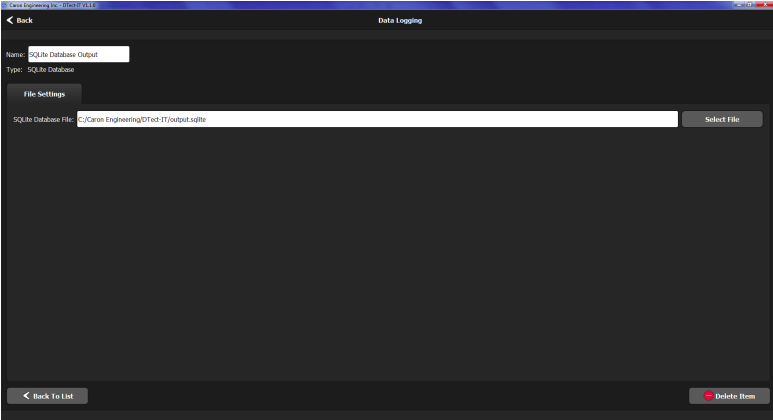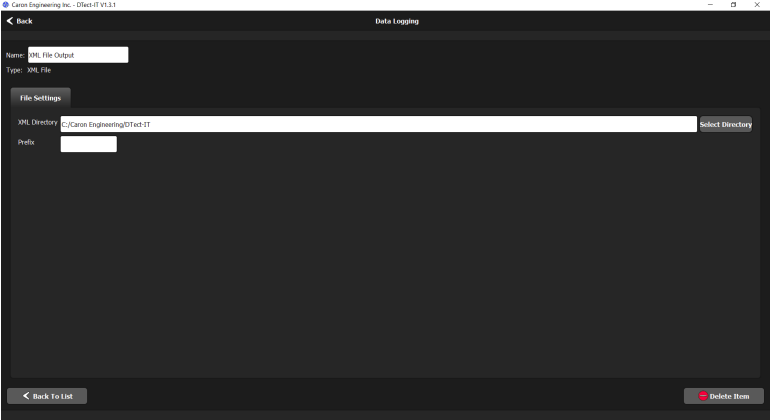Data Logging can be enabled for each analysis. When enabled, DTect-IT creates text files containing data pertaining to the individual analyses. To do this, outputs must be created before using the data logging feature. An output can be created in the Data Logging Setting ribbon or in the Data Logging tab of an analysis setting menu. One output type can be used for multiple analysis. The following data logging outputs are available:
- CSV File Output
- SQLite Database Output
- MTConnect
- XML Output
CSV File Output
DTect-IT can output analysis data to a csv text file. CSV text files can be imported for use in spreadsheet applications. When the CSV output is used, DTect-IT creates a time-stamped CSV file for each start/stop command that occurs.
The data stored in the CSV file varies depending on analysis type. CSV files generate with the following naming convention:
<Prefix_AnalysisName_Specifier_Date_time.csv>
CSV File Output Wizard
The CSV Output wizard eases the setup of an CSV output by guiding the user through the settings step by step. To set up a new CSV output, press the Create button in the Data Logging settings menu and select CSV File. Perform the following steps in the wizard to create the CSV output:
- Press Begin.
- Select the directory location to save the CSV files in.
- Name the CSV output file.
- Press Finish.
After completing the CSV wizard, the CSV output will be available to be utilized by analyses.
CSV File Settings
Press the CSV output button in the Data Logging ribbon to open the settings for the output. The output name and type are displayed here. Press the Name field to rename the output.
File Settings Tab
The following parameters can be set in the file settings tab:
- CSV Directory: This is where data files from analyses using the CSV output are saved. The current directory is displayed and can be changed by pressing the Select Directory button.
- File Prefix: Applies the specified text to the beginning of each file name generated using the output.
- Include Header: Checking this box applies headers to the .csv file representing the data in each column.
SQLite Database Output
DTect-IT can output analysis data to a SQLite Database. A SQLite database stores all data for the specified analysis in one file. This is useful for systems that would generate too many files using the CSV output type.
SQLite database files generate with the following naming convention:
<AnalysisName_Specifier.sqlite>
SQLite Database Output Wizard
The SQLite Database Output wizard eases the setup of an SQLite Database output by guiding the user through the settings step by step. To set up a new SQLite Database output, press the Create button in the Data Logging settings menu and select SQLite Database. Perform the following steps in the wizard to create the SQLite Database output:
- Press Begin.
- Select the database file to save the output in.
- Name the SQLite data logging component.
- Press Finish.
After completing the SQLite Database wizard, the SQLite Database output will be available to be utilized by analyses.
SQLite Settings
Press the SQLite Database output button in the Data Logging ribbon to open the settings for the output. The output name and type are displayed here. Press the Name field to rename the output.
File Settings Tab
The following parameters can be set in the file settings tab:
- SQLite Database File: This is the database file used by analyses that are assigned the SQLite Database output type. The current database file is displayed and can be changed by pressing the Select File button.
MTConnect
DTect-IT is capable of communicating with an MTConnect adapter to provide data from analyses. The CEI MTConnect Manager is needed to utilize this data output type. For more information refer to the MTConnect Manager Quick User's Guide.
MTConnect Data Output Wizard
The MTConnect data Output wizard eases the setup of an MTConnect output by guiding the user through the settings step by step. To set up a new MTConnect output, press the Create button in the Data Logging settings menu and select MTConnect. Perform the following steps in the wizard to create the MTConnect output:
- Press Begin.
- Select the port that will host MTConnect communications.
- Name the MTConnect data output.
- Press Finish.
After completing the MTConnect data output wizard, the MTConnect data output will be available to be utilized by analyses.
MTConnect Connection Settings
Press the MTConnect output button in the Data Logging ribbon to open the settings for the output. The output name and type are displayed here. Press the Name field to rename the output.
Connection Tab
The following parameters can be set in the file settings tab:
- MTConnect Port: The port number that MTConnect communications are occurring on.
XML Output
DTect-IT can output analysis data to an XML file. When the XML output is used, DTect-IT creates a time-stamped XML file for each start/stop command that occurs. The data stored in the XML file varies depending on analysis type.
XML files generate with the following naming convention:
<Prefix_AnalysisName_Specifier_Date_Time.xml>
XML Output Wizard
The XML Output wizard eases the setup of an XML output by guiding the user through the settings step by step. To set up a new XML output, press the Create button in the Data Logging settings menu and select XML. Perform the following steps in the wizard to create the XML output:
- Press Begin.
- Select the directory location to save the XML files in.
- Name the XML .
- Press Finish.
After completing the XML wizard, the XML output will be available to be utilized by analyses.
XML Output Settings
Press the XML output button in the Data Logging ribbon to open the settings for the output. The output name and type are displayed here. Press the Name field to rename the output.
File Settings Tab
The following parameters can be set in the file settings tab:
- XML Directory: This is where data files from analyses using the XML output are saved. The current directory is displayed and can be changed by pressing the Select Directory button.
- File Prefix: Applies the specified text to the beginning of each file name generated using the output.



